The Grid of Things
When it comes to connected things operating interactively and in close harmony with other assets, one just needs to look at the electric grid as a prime example of how efficiencies and optimization can be achieved by leveraging remote monitoring and control. Intelligent grid and network-connected assets can be readily found throughout the transmission, substation and distribution networks. Some of these are shown in Figure 1.
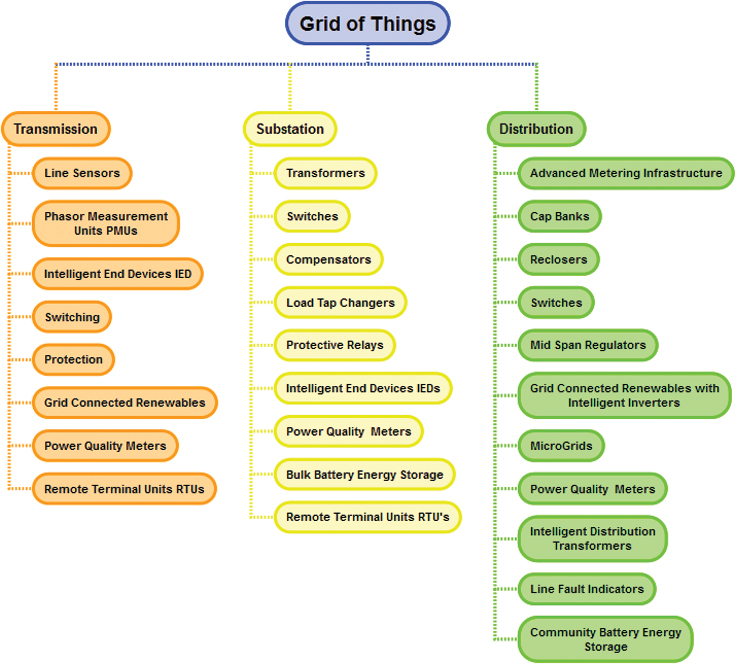
Figure 1: Grid of Things
(click to enlarge)
With assistance from the American Recovery and Reinvestment Act (ARRA) of 2009, increasing numbers of phasor measurement units (PMUs) are now being deployed, monitored and analyzed to provide greater visibility into our transmission network. These intelligent sensors are able to capture millisecond samples of power quality and transient information with extreme accuracy of both the physical measurements and precision time stamping; thus building a repository of data that can help prevent challenges in transmission.
Information that is gathered from PMUs and other line sensors will enable greater use of renewable energy resources to be grid tied at the supply level. When coupled with intelligent inverters that can be controlled by energy management systems (EMS), these assets now become viable assets to support the needs of bulk generation.
The interplay of PMUs and inverters is just one example of how the Grid of Things (GoT) leverages smart assets, communications networks and analytics to drive value to the enterprise.
Connected substations and interaction among connected elements has been a cornerstone of supervisory control and data acquisition (SCADA) operations. Intelligent end devices (IEDs), protective relays, power quality metering, compensation systems, and load tap changers have been orchestrated in concert, to deliver high availability, critical operational optimization and reliable and safe functionality. Standards such as DNP3 and IEC 61850 have helped drive wide acceptance of diverse elements from a variety of suppliers to achieve key operational requirements. Here again, the energy industry has achieved many of the objectives that the generalized IoT target is seeking.
On the distribution network side, there is a large number of assets that are operated either under centralized control or by local autonomous action. Fault location and service restoration (FLISR) is just one example where the operational objective for fast problem isolation, accurate network protection and improved service availability is met with a combination of line sensors that are either integrated into the recloser or provided by remote sensors.
However, with the proliferation of even more sensors and grid re-enforcement tools, such as advanced smart metering and grid connected distributed energy resource assets with smart inverters, the GoT interaction becomes even more critical requiring greater situation awareness and complex power flow models with near real time sensor data to drive algorithms that can be used to achieve the most effective result.
Conservation voltage reduction (CVR) and Volt/VAr optimization (VVO) are also some of the applications that are leveraging the capabilities of Advanced Metering Infrastructure (AMI) that provide near-real time remote voltage monitoring along the feeder to provide closed loop control of line regulators, capacitor banks and load tap changers (LTCs) at the substation. While one may consider that these capabilities can be enabled by simple machine to machine (M2M) communications, the real value of the GoT is achieved when all elements of the solution are fully managed.
Management of all elements in the chain including end devices, communications networks, security and applications, are key characteristics of a GoT that must be in place to ensure the sustainability and viability of a given solution. Configuration data, operational characteristics, device rules, security keys, and core functional foundations, such as operating system (OS) updates are essential characteristics of device management. Providing this over a secure over-the-air process eliminates the need to visit each device. As networks become more integral to the solution, traditional means of network management must be augmented with tools and methods that must now include fail-over configurations, quality of service (QOS) and air-link management. Application management also becomes a critical component of the solution set particularly if this is provided as a cloud-based platform.
Building on the GoT movement is becoming essential to achieve key utility business objectives, such as improving customer average interruption duration index (CAIDI), and system average interruption frequency index (SAIFI) and managing distributed energy resource (DER) hosting capability. GoT is a foundational requirement for effective grid modernization.
Leveraging asset information that is delivered over reliable, robust and readily available communications infrastructures that enable actionable activities driven by analytics is the core foundation for sustainability required by the IoT.
The Internet of Things
Industrial, commercial, consumer and community use of the Internet of Things (IoT) represent another interesting aspect where the ability to leverage asset information command and control is leading to operational transformation.
Some of areas of interest include Commercial and Industrial IoT, Residential IoT and “Smart Cities” IoT.
- Commercial and Industrial IoT
Many industrial users have made significant investments and have a high reliance on process control systems to optimize their operations. Raw sensor data from instruments, such as voltage, current, phase angle, temperature, pressure, flow and humidity, are combined to drive programmable logic controllers (PLC) to manage manufacturing elements. Environmental information, such as occupancy sensors, outdoor temperature, wind, weather forecast, building envelope data, chillers, etc., are orchestrated under Building Management Systems (BMS) to efficiently control facilities.
A high level view of Industrial IoT is shown in Figure 2.
Many of these larger operations are now looking at a microgrid as an alternative to their traditional energy supply. These microgrids are generally equipped with combined heat/ power (CHP), renewable resources, battery storage and load management, and load switching capabilities. Frequently these installations are balancing energy supply requirements against options that include supply from their traditional supplier and/ or self-generation capacity. This optimization decision system focuses on achieving economic supply parity or to avoid peak or ratchet demand charges from their supplier. This mode of continuous optimized operation frequently includes local demand response or energy efficiency measures. Optimization of all of these resources is important when the facility is grid connected or operating in parallel; the measures that must be taken to ensure operations in an island mode are critical particularly when the self-generated resource mix falls short of the load it is required to support. Effective islanding mode must include levels of load shed and balancing. Intelligence is mandatory to ensure safe operation during island mode. This is most acute when system re-synchronization is required during re-establishment of a grid connection.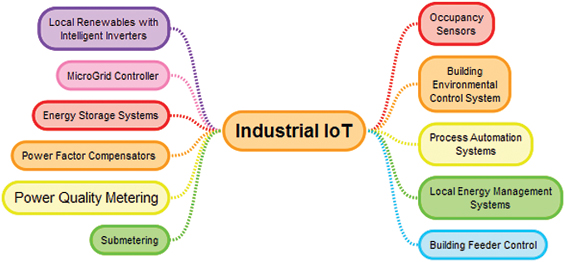
Figure 2: Industrial IoT
- Residential IoT
In the Residential IoT space, there has been a growing interest in Home automation (HA).Many providers are offering customers the ability to manage their lighting systems, media centers and even white-good appliances using device connectivity. There is an explosion of connected devices communicating over Wi-Fi directly or over Z-Wave, or ZigBee bridges that are connected to the internet to access simple interactive and intuitive applications that can be found on smartphones. While for some time this was considered to be a home hobbyist domain, connected home applications are among the fastest growing consumer market. With the advent of Amazon Echo (Alexa) and Google Connect (hey google), the technical knowledge needed to automate a residence has dropped drastically. The Consumer Electronics Show this year had thousands of devices that had some energy management capability pre-integrated with Alexa.
Some of the Residential IoT areas are highlighted in Figure 3.
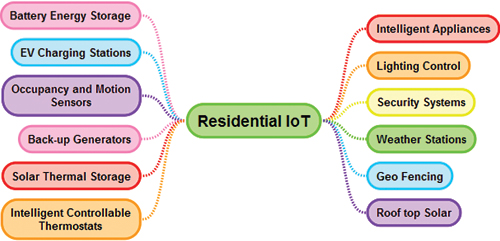
Figure 3: Residential IoT
- Smart Cities and IoT
Smart Cities is a very topical discussion among municipalities seeking to leverage available assets such as streetlights and emerging community interests. Many utilities are evaluating how to provide community services such as intelligent parking space monitoring, traffic signal flow management, intelligent LED-based street lighting, camera surveillance, bus arrival times, emergency call buttons and so forth. Municipal entities are seeking ways to monetize these applications through smart advertising and other commercial methods, while approaching communications carriers to take advantage of the existing streetlight real estate to enable small cell networks.
Smart Cities applications frequently leverage sensors, such as motion or occupancy, to adjust street light illumination, resulting in economic savings from lower energy usage when full illumination is not necessary. Centralized knowledge about streetlight outages also reduces labor costs associated with traditional activities. In a similar fashion to payphones of the past, intelligent lighting assets are a natural location for electric vehicle charging stations. Common “Smart Cities” IoT applications are shown in Figure 4 below.
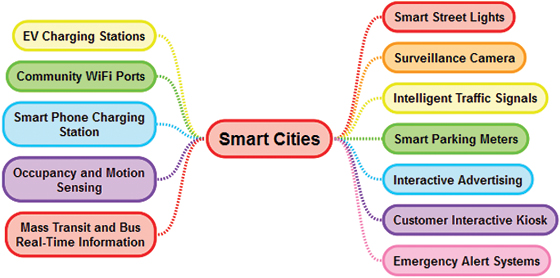
Figure 4: Smart Cities IoT
Holistically Orchestrated Things (HoT)
Although each particular area of IoT is of unique interest, there is a need to exploit the intersection of GoT and IoT, in an area identified as Holistically Orchestrated Things (HoT). See Figure 5.
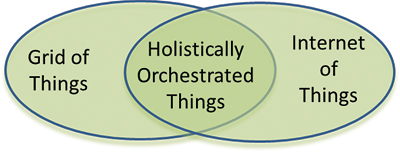
Figure 5: Holistically Orchestrated Things
GoT and Industrial IoT
The opportunity for coordination among these domains focuses on transforming the relationship between grid providers and load entities from a “service delivery point” to an “energy partner.” This will become increasingly more prevalent as customer or jointly owned and operated supply assets transactively participate with the grid.
With lower-cost renewable assets finding their way on to facility rooftops or parking lots, many passive energy user customers are forging into deeper understanding of the potential energy value they can provide. Possible intersecting areas for Industrial IoT and the grid include:
- Short-term grid support during anomalies (e.g. Voltage/Frequency Ride through) – With the direction of IEEE 1547a, grid support functionality will need to be supported. The control of this may be an augmentation of a Distributed Energy Resource Management System (DERMS).
- Improving grid stability by using customer-owned compensation elements – Since some facilities have capacitor compensation to overcome local VAr conditions, these assets may be called upon by the utility to augment utility-owned assets.
- Intelligent building control response to demand response requirements – Leveraging the intelligence within a building management system may offer new tiers of potential demand reduction based on occupancy sensors, build envelop characteristics, etc.
- Coincident Demand Peak Avoidance – With grid-wide knowledge of demand characteristics, intelligent load control and sequencing may be used to minimize co-incident peak situations.
- Customer based thermal/energy storage to as a Non-Wires Alternative (NWA) – As utilities seek short-term options to new construction or re-enforcement, customer owned assets or potentially co-owned assets may be leveraged to overcome seasonal peak demands.
- Microgrid optimization – Utilities are in a position to help customers better understand their options for supply, load management and load profile characteristics.
- Outsourced MicroGrid operations and maintenance – With increasing intelligence provisioned within the facility microgrid controller, utilities may be in unique position to provide services to support internal staff for operations and maintenance (O&M) as a service (when permitted).
Grid and Residential IoT
Although the individual contribution of any single residential energy provider may not be significant, aggregation of functionality and services provide an interesting potential area for greater exploration. Some of the intersecting areas of interest include:
- Intelligent Demand Response – Leveraging occupancy sensors and next generation thermostats that profile temperature recovery can provide new options for demand management.
- Advanced Time of Use (TOU) applications – With intelligent appliances and smart apps, the goal of autonomous, predictable and user-friendly, time-of-use device interaction may be realized.
- Vehicle to Grid (V2G) – With intelligent charging stations combined with knowledge-rich electric vehicles, the use of this customer asset may now effectively leverage grid conditions to react accordingly while still ensuring customer needs for convenience and cost.
Grid and Smart Cities IoT
Smart Cities provide additional potential for intersection of HoT.Some of the potential areas for collaborative value between “Smart Cities” and utilities include:
- Common use for Communications Infrastructure – Many AMI providers have already incorporated smart street light applications as part of their offering suite. Including streetlights as nodes on an AMI network has shown to improve performance, lower latency and deliver.
- Gateway for fixed radio AMR – The potential exists to leverage these assets as a home for collection gateways for older automated meter reading (AMR) that use a drive-by methodology.
- Intelligent EV Charging Stations – Since many of these assets would be located near vehicle parking, intelligence using Near Field Communication (NFC) or other tagging could be used to provide smart charging programs.
- Smart Lighting Control – LED replacement for traditional overhead lights can result in substantial savings (30-50%) and when coupled with motion sensing can further reduce many of these unmetered services by another 10%.
- Streetlight Outage Response – Leveraging luminary intelligence, servicing of dark lights can be optimized.
Conclusion
The collaboration between the GoT and the IoT provide opportunities for synergy, growth and innovative ways to bring value to the utility, customers and the community.
About the Author
 Ron Chebra, EnerNex Vice President of Grid Modernization, is a recognized thought leader and industry expert in utility modernization. He has a deep operating knowledge in technology solutions in areas such as MicroGrids, Renewable Energy Integration, Smart Grid, Distribution Automation (DA), Advanced Metering Infrastructure (AMI) and Demand Response. He provides strategic consulting services to leading energy industry suppliers of products and services, in the following areas: microgrids, demand response, battery energy storage solutions and “Behind the Meter” technologies. Ron has over 35 years of experience, including previous positions with Schneider Electric and DNV GL.
Ron Chebra, EnerNex Vice President of Grid Modernization, is a recognized thought leader and industry expert in utility modernization. He has a deep operating knowledge in technology solutions in areas such as MicroGrids, Renewable Energy Integration, Smart Grid, Distribution Automation (DA), Advanced Metering Infrastructure (AMI) and Demand Response. He provides strategic consulting services to leading energy industry suppliers of products and services, in the following areas: microgrids, demand response, battery energy storage solutions and “Behind the Meter” technologies. Ron has over 35 years of experience, including previous positions with Schneider Electric and DNV GL.







